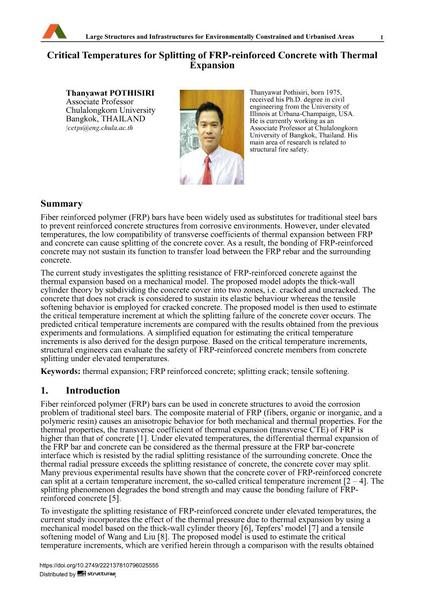Critical Temperatures for Splitting of FRP-reinforced Concrete with Thermal Expansion

|
|
|||||||||||
Détails bibliographiques
| Auteur(s): |
Thanyawat Pothisiri
|
||||
|---|---|---|---|---|---|
| Médium: | papier de conférence | ||||
| Langue(s): | anglais | ||||
| Conférence: | IABSE Symposium: Large Structures and Infrastructures for Environmentally Constrained and Urbanised Areas, Venice, Italy, 22-24 September 2010 | ||||
| Publié dans: | IABSE Symposium Venice 2010 | ||||
|
|||||
| Page(s): | 504-505 | ||||
| Nombre total de pages (du PDF): | 8 | ||||
| Année: | 2010 | ||||
| DOI: | 10.2749/222137810796025555 | ||||
| Abstrait: |
Fiber reinforced polymer (FRP) bars have been widely used as substitutes for traditional steel bars to prevent reinforced concrete structures from corrosive environments. However, under elevated temperatures, the low compatibility of transverse coefficients of thermal expansion between FRP and concrete can cause splitting of the concrete cover. As a result, the bonding of FRP-reinforced concrete may not sustain its function to transfer load between the FRP rebar and the surrounding concrete. The current study investigates the splitting resistance of FRP-reinforced concrete against the thermal expansion based on a mechanical model. The proposed model adopts the thick-wall cylinder theory by subdividing the concrete cover into two zones, i.e. cracked and uncracked. The concrete that does not crack is considered to sustain its elastic behaviour whereas the tensile softening behavior is employed for cracked concrete. The proposed model is then used to estimate the critical temperature increment at which the splitting failure of the concrete cover occurs. The predicted critical temperature increments are compared with the results obtained from the previous experiments and formulations. A simplified equation for estimating the critical temperature increments is also derived for the design purpose. Based on the critical temperature increments, structural engineers can evaluate the safety of FRP-reinforced concrete members from concrete splitting under elevated temperatures. |
||||
